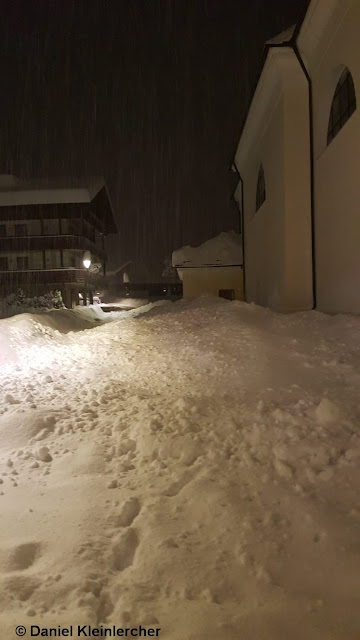Glide-snow problem on grassy slopes. Caution: rooftop avalanches.
Let’s first look at the regions where precipitation has been heaviest. There have been record-breaking amounts of fresh snow registered since Friday, 4 December.
 |
| Record-setting precipitation in Lienz (measurements since 1880) |
 |
| Since Tirol’s Avalanche Warning Service was established in 1960, there have never been such masses of snow seen in Obertilliach at this juncture of the season. |
In the interim the snowpack is settling well. This brings about further densification of the snow cover and stabilisation of the interior snow masses. For that reason naturally triggered slab avalanches can be almost ruled out.
However, the entire snowpack can glide away, over steep, smooth surfaces. This tends to occur on grass-covered slopes. We also observe it in steep rocky terrain...or over smooth rooftops of houses. Therefore: caution towards rooftop avalanches!
 |
| Glide-snow avalanches in Defereggental (photo: 09.12.2020) |
 |
| Deposit from a rooftop avalanche, St. Jakob i.Def. (photo: 07.12.2020) |
One of the major prerequisites for this: a moist snowpack at its base. Rainfall on 5-6 December, often extending up to 1500 m and higher, injected lots of moisture into the snowpack. This furthers the gliding process and the initial release of gliding snow masses. The snow masses themselves also play a part: the deeper the snow, the greater is the sliding tendency.
Today, 10 December, for example, a road near Leiten in southern East Tirol was buried by a glide-snow avalanche. An immediate search operation revealed that no persons came to grief.
 |
| Road in Leiten district, southern East Tirol, buried in a glide-snow avalanche (photo: 10.12.2020) |
The dilemma with glide-snow avalanches is that they can’t be artificially triggered by explosives. And their moment-of-release is impossible to predict.
Sole solution: increasing ground roughness, e.g. through building measures. In addition to that: when possible, don’t stop anywhere below glide cracks in the snowpack surface.
 |
| Avalanche-protection constructions prevent or at least hinder gliding snow masses, Defereggental. (photo: 07.12.2020) |
Old-snow problem in northern regions
We refer to an old-snow problem when there are weak layers which remain prone to triggering for longish periods inside the snowpack. The current weak layers were generated during the extended fine-weather phase in November. Particularly in regions where there is little snow, they can easily be triggered by winter sports enthusiasts. Confirming this diagnosis: whumpf noises have been observed recently; moreover, some avalanches have actually triggered.
 |
| Naturally triggered avalanche, Schindlergrat, Arlberg region. Weak layer brought about by surface hoar. (photo: 07.12.2020) |
 |
| Avalanche Warther Horn, near the Tirol/Vorarlberg border. Triggered by winter sports enthusiast, partially buried in snow, no injuries. (photo: 07.12.2020) |
 |
| Avalanche triggered near ground level due to overload from snowdrifts, Patscherkofel near Innsbruck. (photo: 08.12.2020) |
Caution is essential wherever there was a cohesive, area-wide snowpack prior to the recent snowfall. That means shady terrain above about 2000 m and sunny terrain about about 2500 m (usually higher up on south-facing slopes) in particular.
In isolated cases, even large-to-very large sized avalanches can be triggered in the regions where snowfall has been heaviest due to the old-snow problem, particularly along the Main Alpine Ridge. This is only conceiveable from loads where there is not a deep snowpack, a situation becoming more unlikely with each passing day yet whose consequences are awful if it does happen. In other words: (very) low probability, (very) high consequence. This is corroborated by recently achieved successes from artificial triggerings, as well as one documented avalanche which a ski-piste vehicle triggered (no consequences).
A snowpack simulation analysis is also revealing. Proneness to triggering by a skier is calculated on a fictitious 38° slope. The result: currently high trigger-sensitivity, tendency slowly diminishing.
Short-term danger of loosely-packed avalanches
In regions where there has been a great deal of snowfall, even larger-sized loosely-packed avalanches have been observed in extremely steep terrain over the last few days, ordinarily triggered by external impulses, e.g. a falling tree. This threat will rapidly diminish as the settling of the snowpack continues.
 |
| Deposit of a loosely-packed avalanche, Zirmbachalm (photo: 08.12.2020) |
A few images from this last week
 |
| Unburying a car, Lienz (photo. 07.12.2020) |
 |
| Avalanche over the road shed, Felbertauern (photo: 09.12.2020) |
 |
| Wild animals in distress, St. Sigmund (photo: 08.12.2020) |
 |
| Deer freed from deep snow, carried to feeding station, St. Sigmund (photo: 08.12.2020) |
 |
| Once again, after 2018 and 2019, lots of fallen trees in East Tirol (photo: 09.12.2020) |





